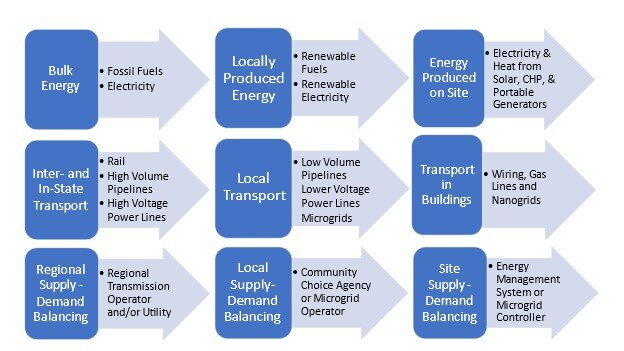California now finds it necessary to shut parts of the state-wide electricity grid down where and when high winds, power lines and dry vegetation threaten to cause wildfires. Prompted by wildfire experience and anticipating further and more severe wildfires, an energy resilience conversation is beginning in California. Energy resilience is the ability to restore energy supplies quickly even when they are severely disrupted. High levels of energy resilience minimize costs and economic dislocation in the wake of natural disasters. Energy resilience is made possible by on-site and community based electricity sources producing energy commodities that community choice providers, microgrids and nanogrids collect to meet site and local demand. The figure below shows bulk energy supplementing locally produced energy supplementing energy produced on site.

Integrated Regional Energy System
A proposed CPUC decision sets aside a long-standing bipartisan policy regarding on-site solar energy. The policy should remain in effect because it is foundational to creation of a just and affordable state-wide renewable energy eco-system. Its underlying premises are valid. The underlying premises of the proposed decision are not. Better informed and more robust on-going and future consideration of the benefits of rooftop solar can be a positive outcome of the current policy tug of war between electric utilities and local clean energy advocates.
California has ramped up a seventy-six billion dollar investment in all types of solar generation capacity over the past decade. California’s retail solar industry enabled half of the total investment. Rooftop solar has been a bright spot for California’s renewable energy transition even as state regulators and California utilities continue to make other energy democracy enablers - community choice, community solar, community microgrids - hard or impossible to finance.
Regulators are now considering rule changes that impose punitive “grid access” fees on rooftop solar adoption, plus drastic reductions in compensation for electricity that feeds into the grid from rooftop solar arrays. The future of energy democracy in California hangs in the balance.
[1] The proposed CPUC decision is not accompanied by case studies indicating how it will work out for ratepayers.
On-site solar is the lowest impact, most economically beneficial renewable supply option available to California legislators, policy makers, utilities and energy users. The best state-wide balance between locally produced solar electricity and the output of large solar power plants depends on the best balance for each California city and county. Striking the right balance should be a local choice. For now, the option to produce solar electricity to meet local needs must be expanded, not curtailed.
When IRESN took up the topic of “integrated renewable energy systems” a decade ago, we imagined an expanding renewable integration challenge driven by community-scale and building-scale renewable energy systems as well by utility-scale power plants. Now new technologies are changing what we imagined into a real and urgent challenge. The figure summarizes vectors of energy sector change that are already in effect. Collaborative planning will need to be local as well as regional.
There is anecdotal evidence of the need for collaboration. For proponents of local clean energy resources there is an even more basic question. Why energy resources that are both clean and local? The case is compelling.
Simply put, local¹ clean energy resources are happening, unevenly around the world, mostly, except for California, outside the US. They come in many sizes. So do utilities. So do cities. Maybe we need a common denominator if we are to connect dots more strategically and less anecdotally.






California and other states need a way to capture the environmental and economic benefits of community solar. Other states have found a way. California’s CCE industry should ask the California legislature to consider allowing California CCEs to use all or a portion of annual CPUC mandated PCIA charges to put local renewable projects on an equal economic footing with projects that require new high voltage transmission capacity to deliver electricity locally. This will increase CCE capacity and flexibility to address local energy resilience needs and to provide equitable access locally to the environmental and economic benefits of solar electricity.